cooling FORD SIERRA 1983 1.G Routine Manintenance And Servicing Workshop Manual
[x] Cancel search | Manufacturer: FORD, Model Year: 1983, Model line: SIERRA, Model: FORD SIERRA 1983 1.GPages: 22, PDF Size: 1.26 MB
Page 2 of 22

Cooling system
Drivebelt tensions:
Air conditioning system compressor . . . . . . . . . . . . . . . . . . . . . . . . .10.0 mm (0.4 in) deflection at the midpoint of the belt’s longest run
under firm thumb pressure
Coolant pump/alternator . . . . . . . . . . . . . . . . . . . . . . . . . . . . . . . . . .10.0 mm (0.4 in) deflection midway between coolant pump and
alternator (or power steering pump) pulleys under firm thumb pressure
Fuel system
Air filter element:
Carburettor type:
1.3 and 1.6 litre (SOHC - Ford carburettor) . . . . . . . . . . . . . . . . . .Champion W110
1.6 litre (SOHC - Weber carburettor) and 1.8 litre SOHC . . . . . . . .Champion W118
1.6 litre (SOHC - 1984-on) and 2.0 litre SOHC . . . . . . . . . . . . . . . .Champion W152
1.8 litre CVH . . . . . . . . . . . . . . . . . . . . . . . . . . . . . . . . . . . . . . . . . .Champion W219
2.0 litre DOHC . . . . . . . . . . . . . . . . . . . . . . . . . . . . . . . . . . . . . . . . .Champion W152
Fuel injection type:
2.0 litre SOHC and DOHC . . . . . . . . . . . . . . . . . . . . . . . . . . . . . . . .Champion U507
1.6 and 1.8 litre (R6A type) CVH . . . . . . . . . . . . . . . . . . . . . . . . . . .Champion W219
Fuel filter:
All fuel injection models . . . . . . . . . . . . . . . . . . . . . . . . . . . . . . . . . . .Champion L204
Ignition system
Spark plugs:
Make and type:
All except 1.8 CVH, CVH (R6A), 2.0 DOHC and P100 . . . . . . . . . . . .Champion RF7YCC or RF7YC
1.8 litre CVH . . . . . . . . . . . . . . . . . . . . . . . . . . . . . . . . . . . . . . . . . . . .Champion RC7YCC or RC7YC
P100 . . . . . . . . . . . . . . . . . . . . . . . . . . . . . . . . . . . . . . . . . . . . . . . . . .Champion RF7YC or F7YC
1.6 and 1.8 litre (R6A type) CVH . . . . . . . . . . . . . . . . . . . . . . . . . . . . .Champion RC7YCC
2.0 litre DOHC . . . . . . . . . . . . . . . . . . . . . . . . . . . . . . . . . . . . . . . . . . .Champion RC7YCC
Electrode gap*:
Champion F7YCC or RC7YCC . . . . . . . . . . . . . . . . . . . . . . . . . . . . . .0.8 mm (0.032 in)
Champion RF7YC, F7YC or RC7YC . . . . . . . . . . . . . . . . . . . . . . . . . .0.7 mm (0.028 in)
Ignition HT leads
Resistance . . . . . . . . . . . . . . . . . . . . . . . . . . . . . . . . . . . . . . . . . . . . . . .30 k ohms maximum per lead
Type:
All SOHC models . . . . . . . . . . . . . . . . . . . . . . . . . . . . . . . . . . . . . . . .Champion LS-09 or LS-10 boxed set
1.8 litre CVH . . . . . . . . . . . . . . . . . . . . . . . . . . . . . . . . . . . . . . . . . . . .Champion LS-10 boxed set
1.6 and 1.8 litre (R6A type) CVH . . . . . . . . . . . . . . . . . . . . . . . . . . . .Champion LS-30 boxed set
2.0 litre DOHC . . . . . . . . . . . . . . . . . . . . . . . . . . . . . . . . . . . . . . . . . . .Champion LS-29 boxed set
*The spark plug gap quoted is that recommended by Champion for their specified plugs listed above. If spark plugs of any other type are to be
fitted, refer to their manufacturer’s recommendations.
Brakes
Brake pad friction material minimum thickness . . . . . . . . . . . . . . . . . . .1.5 mm (0.06 in)
Brake shoe friction material minimum thickness . . . . . . . . . . . . . . . . . .1.0 mm (0.04 in)
Torque wrench settingsNmlbf ft
Engine oil drain plug:
SOHC and DOHC . . . . . . . . . . . . . . . . . . . . . . . . . . . . . . . . . . . . . . . .21 to 2816 to 21
CVH . . . . . . . . . . . . . . . . . . . . . . . . . . . . . . . . . . . . . . . . . . . . . . . . . . .20 to 3015 to 22
Engine block coolant drain plug (where fitted) . . . . . . . . . . . . . . . . . . . .21 to 25 16 to 18
Manual gearbox:
Oil filler/level plug:
A,B,C and N types . . . . . . . . . . . . . . . . . . . . . . . . . . . . . . . . . . . . .33 to 4124 to 30
MT75 type . . . . . . . . . . . . . . . . . . . . . . . . . . . . . . . . . . . . . . . . . . . .29 to 4121 to 30
Oil drain plug:
MT75 type . . . . . . . . . . . . . . . . . . . . . . . . . . . . . . . . . . . . . . . . . . . .29 to 4121 to 30
Final drive oil filler plug . . . . . . . . . . . . . . . . . . . . . . . . . . . . . . . . . . . . . .35 to 4526 to 33
Roadwheel nuts:
Saloon, Hatchback and Estate models (steel and alloy wheels) . . . .70 to 10052 to 74
P100 models . . . . . . . . . . . . . . . . . . . . . . . . . . . . . . . . . . . . . . . . . . . .85 to 9063 to 66
Spark plugs:
SOHC models . . . . . . . . . . . . . . . . . . . . . . . . . . . . . . . . . . . . . . . . . . .20 to 2815 to 21
CVH models . . . . . . . . . . . . . . . . . . . . . . . . . . . . . . . . . . . . . . . . . . . .18 to 3313 to 24
DOHC models . . . . . . . . . . . . . . . . . . . . . . . . . . . . . . . . . . . . . . . . . . .15 to 2111 to 15
Brake caliper guide bolts:
Front . . . . . . . . . . . . . . . . . . . . . . . . . . . . . . . . . . . . . . . . . . . . . . . . . .20 to 2515 to 18
Rear . . . . . . . . . . . . . . . . . . . . . . . . . . . . . . . . . . . . . . . . . . . . . . . . . . .31 to 3523 to 26
1•2Servicing specifications
Page 3 of 22

The maintenance intervals in this manual
are provided with the assumption that you will
be carrying out the work yourself. These are
the minimum maintenance intervals
recommended by the manufacturer for
vehicles driven daily. If you wish to keep your
vehicle in peak condition at all times, you maywish to perform some of these procedures
more often. We encourage frequent
maintenance, because it enhances the
efficiency, performance and resale value of
your vehicle.
If the vehicle is driven in dusty areas, used
to tow a trailer, or driven frequently at slowspeeds (idling in traffic) or on short journeys,
more frequent maintenance intervals are
recommended.
When the vehicle is new, it should be
serviced by a factory-authorised dealer
service department, in order to preserve the
factory warranty.
Capacities
Engine oil
SOHC engines:
With filter . . . . . . . . . . . . . . . . . . . . . . . . . . . . . . . . . . . . . . . . . . . . . . .3.75 litres (6.6 pints)
Without filter . . . . . . . . . . . . . . . . . . . . . . . . . . . . . . . . . . . . . . . . . . . .3.25 litres (5.7 pints)
DOHC engine:
With filter . . . . . . . . . . . . . . . . . . . . . . . . . . . . . . . . . . . . . . . . . . . . . . .4.5 litres (7.9 pints)
Without filter . . . . . . . . . . . . . . . . . . . . . . . . . . . . . . . . . . . . . . . . . . . .4.0 litres (7.0 pints)
1.6 litre CVH engine:
With filter . . . . . . . . . . . . . . . . . . . . . . . . . . . . . . . . . . . . . . . . . . . . . . .3.5 litres (6.2 pints)
Without filter . . . . . . . . . . . . . . . . . . . . . . . . . . . . . . . . . . . . . . . . . . . .3.25 litres (5.7 pints)
1.8 CVH engines:
With filter . . . . . . . . . . . . . . . . . . . . . . . . . . . . . . . . . . . . . . . . . . . . . . .4.0 litres (7.0 pints)
Without filter . . . . . . . . . . . . . . . . . . . . . . . . . . . . . . . . . . . . . . . . . . . .3.5 litres (6.2 pints)
Cooling system (including heater)
SOHC engines . . . . . . . . . . . . . . . . . . . . . . . . . . . . . . . . . . . . . . . . . . . .8.0 litres (14.1 pints)
DOHC engine:
Carburettor models . . . . . . . . . . . . . . . . . . . . . . . . . . . . . . . . . . . . . . .7.0 litres (12.3 pints)
Fuel injection models . . . . . . . . . . . . . . . . . . . . . . . . . . . . . . . . . . . . .7.3 litres (12.8 pints)
CVH engines:
1.6 and 1.8 litre (R2A) . . . . . . . . . . . . . . . . . . . . . . . . . . . . . . . . . . . . .9.5 litres (16.7 pints)
1.8 litre (R6A) . . . . . . . . . . . . . . . . . . . . . . . . . . . . . . . . . . . . . . . . . . .7.9 litres (13.9 pints)
Fuel tank
All models except P100 . . . . . . . . . . . . . . . . . . . . . . . . . . . . . . . . . . . . .60.0 litres (13.2 gals)
P100 models . . . . . . . . . . . . . . . . . . . . . . . . . . . . . . . . . . . . . . . . . . . . . .66.0 litres (14.5 gals)
Manual gearbox
A1 and A2 types . . . . . . . . . . . . . . . . . . . . . . . . . . . . . . . . . . . . . . . . . . .0.98 litre (1.72 pints)
B type . . . . . . . . . . . . . . . . . . . . . . . . . . . . . . . . . . . . . . . . . . . . . . . . . . .1.46 litres (2.57 pints)
C type . . . . . . . . . . . . . . . . . . . . . . . . . . . . . . . . . . . . . . . . . . . . . . . . . . .1.25 litres (2.20 pints)
N type up to 1987 . . . . . . . . . . . . . . . . . . . . . . . . . . . . . . . . . . . . . . . . . .1.90 litres (3.34 pints)
N type from 1987 . . . . . . . . . . . . . . . . . . . . . . . . . . . . . . . . . . . . . . . . . .1.25 litres (2.20 pints)
MT75 type . . . . . . . . . . . . . . . . . . . . . . . . . . . . . . . . . . . . . . . . . . . . . . . .1.2 litres (2.1 pints)
Automatic transmission
C3 type . . . . . . . . . . . . . . . . . . . . . . . . . . . . . . . . . . . . . . . . . . . . . . . . . .6.3 litres (11.1 pints)
A4LD type . . . . . . . . . . . . . . . . . . . . . . . . . . . . . . . . . . . . . . . . . . . . . . . .8.5 litres (15.0 pints)
Final drive (from dry)
All models except 1.3 and 1.6 litre Hatchback and P100 . . . . . . . . . . .0.9 litre (1.6 pints)
1.3 and 1.6 litre Hatchback models . . . . . . . . . . . . . . . . . . . . . . . . . . . .0.8 litre (1.4 pints)
P100 models (rear axle) . . . . . . . . . . . . . . . . . . . . . . . . . . . . . . . . . . . . .1.14 litres (2.0 pints)
Power steering
All models . . . . . . . . . . . . . . . . . . . . . . . . . . . . . . . . . . . . . . . . . . . . . . . .0.65 litre (1.14 pints)
Servicing specifications 1•3
1
1Ford Sierra maintenance schedule
Page 6 of 22
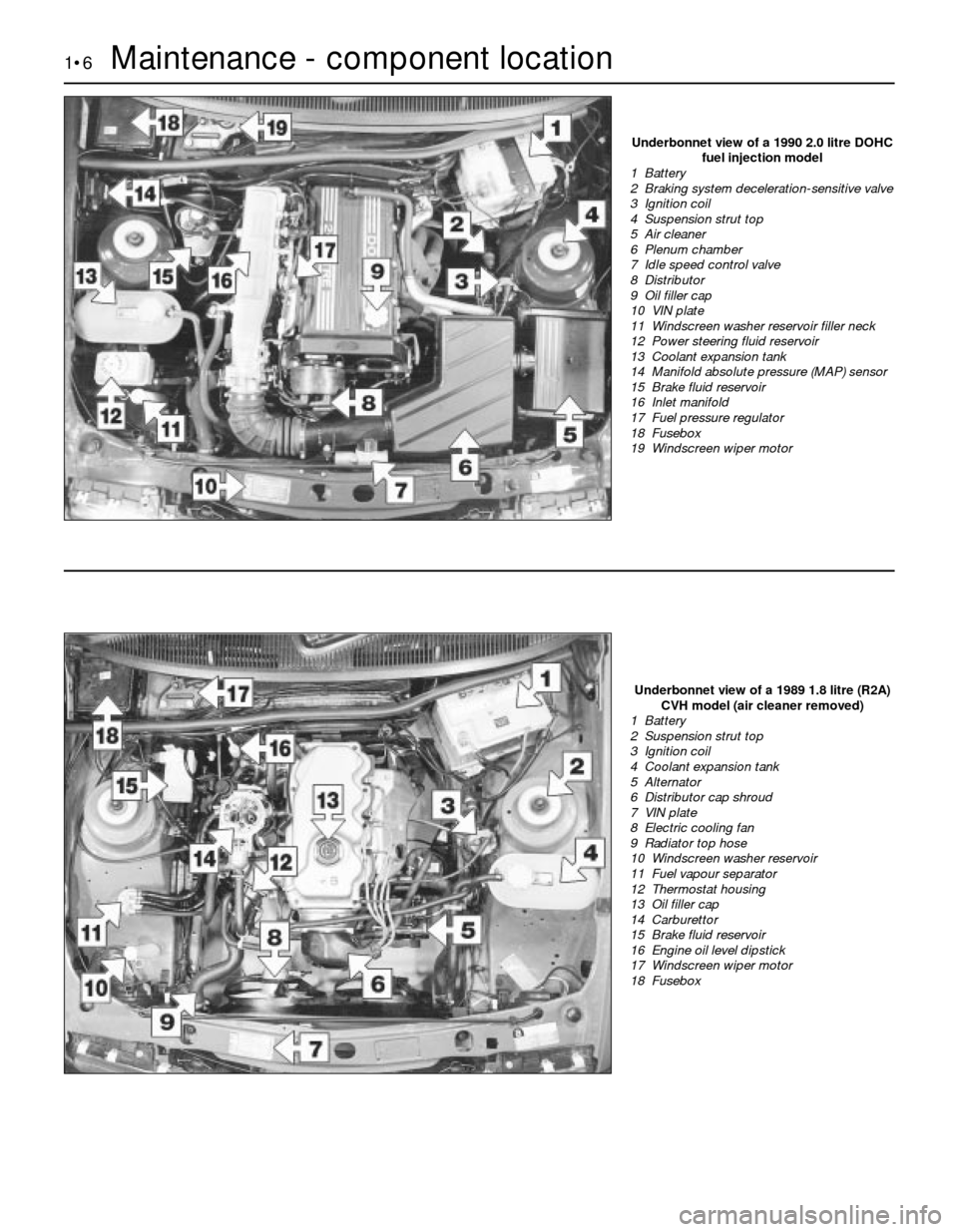
1•6Maintenance - component location
Underbonnet view of a 1990 2.0 litre DOHC
fuel injection model
1 Battery
2 Braking system deceleration-sensitive valve
3 Ignition coil
4 Suspension strut top
5 Air cleaner
6 Plenum chamber
7 Idle speed control valve
8 Distributor
9 Oil filler cap
10 VIN plate
11 Windscreen washer reservoir filler neck
12 Power steering fluid reservoir
13 Coolant expansion tank
14 Manifold absolute pressure (MAP) sensor
15 Brake fluid reservoir
16 Inlet manifold
17 Fuel pressure regulator
18 Fusebox
19 Windscreen wiper motor
Underbonnet view of a 1989 1.8 litre (R2A)
CVH model (air cleaner removed)
1 Battery
2 Suspension strut top
3 Ignition coil
4 Coolant expansion tank
5 Alternator
6 Distributor cap shroud
7 VIN plate
8 Electric cooling fan
9 Radiator top hose
10 Windscreen washer reservoir
11 Fuel vapour separator
12 Thermostat housing
13 Oil filler cap
14 Carburettor
15 Brake fluid reservoir
16 Engine oil level dipstick
17 Windscreen wiper motor
18 Fusebox
Page 7 of 22
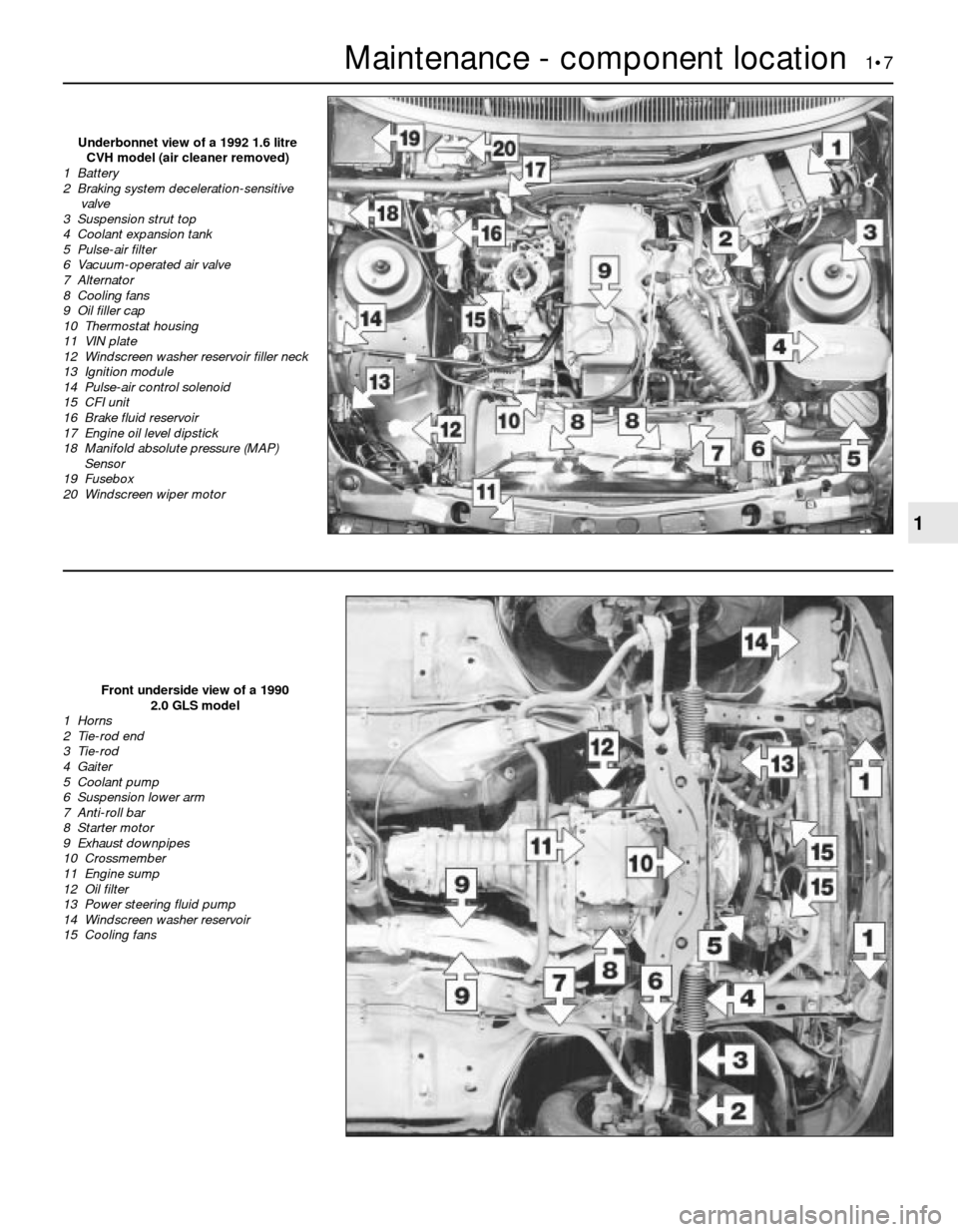
Maintenance - component location 1•7
1
Front underside view of a 1990
2.0 GLS model
1 Horns
2 Tie-rod end
3 Tie-rod
4 Gaiter
5 Coolant pump
6 Suspension lower arm
7 Anti-roll bar
8 Starter motor
9 Exhaust downpipes
10 Crossmember
11 Engine sump
12 Oil filter
13 Power steering fluid pump
14 Windscreen washer reservoir
15 Cooling fans
Underbonnet view of a 1992 1.6 litre
CVH model (air cleaner removed)
1 Battery
2 Braking system deceleration-sensitive
valve
3 Suspension strut top
4 Coolant expansion tank
5 Pulse-air filter
6 Vacuum-operated air valve
7 Alternator
8 Cooling fans
9 Oil filler cap
10 Thermostat housing
11 VIN plate
12 Windscreen washer reservoir filler neck
13 Ignition module
14 Pulse-air control solenoid
15 CFI unit
16 Brake fluid reservoir
17 Engine oil level dipstick
18 Manifold absolute pressure (MAP)
Sensor
19 Fusebox
20 Windscreen wiper motor
Page 12 of 22
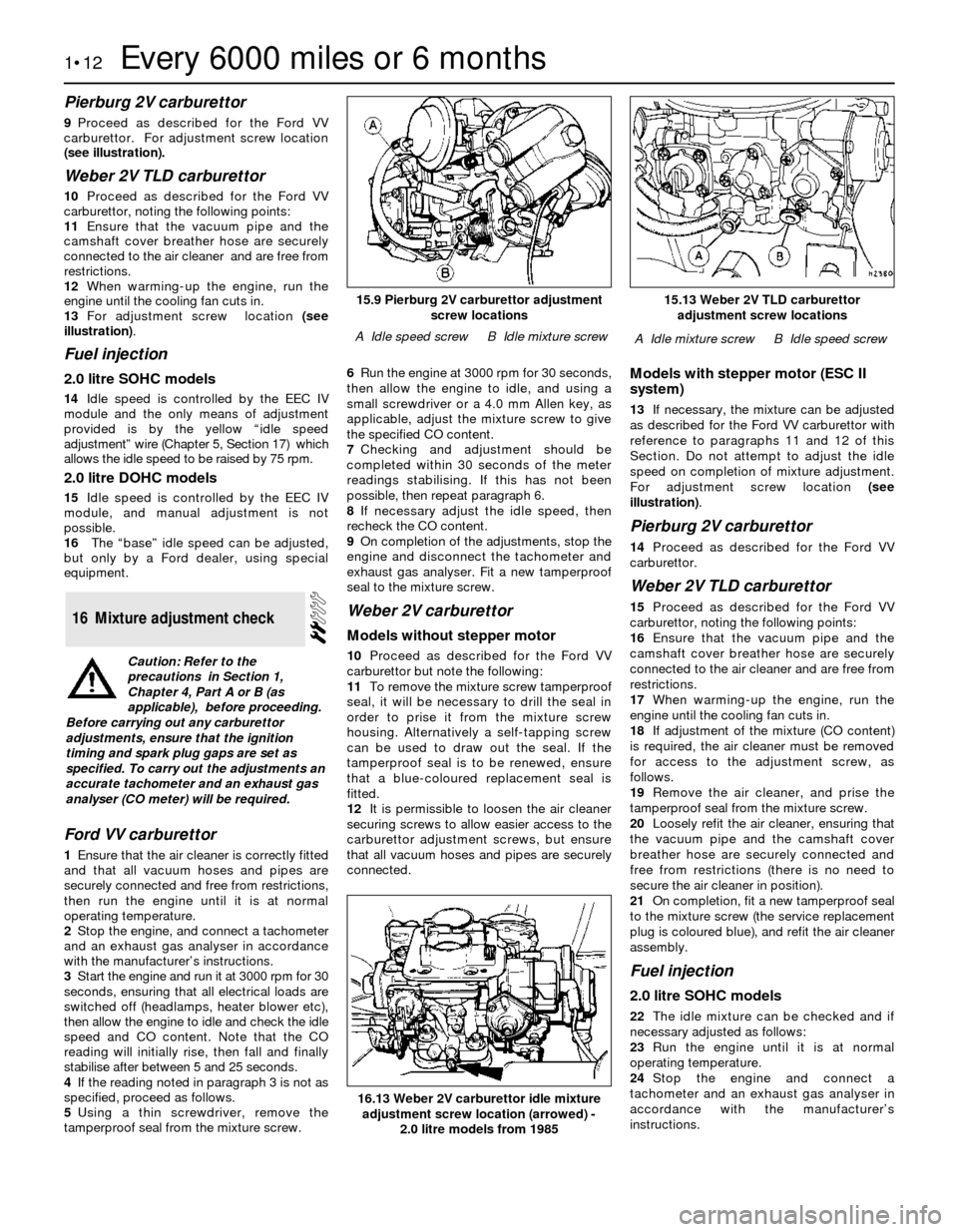
Pierburg 2V carburettor
9Proceed as described for the Ford VV
carburettor. For adjustment screw location
(see illustration).
Weber 2V TLD carburettor
10Proceed as described for the Ford VV
carburettor, noting the following points:
11Ensure that the vacuum pipe and the
camshaft cover breather hose are securely
connected to the air cleaner and are free from
restrictions.
12When warming-up the engine, run the
engine until the cooling fan cuts in.
13For adjustment screw location (see
illustration).
Fuel injection
2.0 litre SOHC models
14Idle speed is controlled by the EEC IV
module and the only means of adjustment
provided is by the yellow “idle speed
adjustment” wire (Chapter 5, Section 17) which
allows the idle speed to be raised by 75 rpm.
2.0 litre DOHC models
15Idle speed is controlled by the EEC IV
module, and manual adjustment is not
possible.
16The “base” idle speed can be adjusted,
but only by a Ford dealer, using special
equipment.
Ford VV carburettor
1Ensure that the air cleaner is correctly fitted
and that all vacuum hoses and pipes are
securely connected and free from restrictions,
then run the engine until it is at normal
operating temperature.
2Stop the engine, and connect a tachometer
and an exhaust gas analyser in accordance
with the manufacturer’s instructions.
3Start the engine and run it at 3000 rpm for 30
seconds, ensuring that all electrical loads are
switched off (headlamps, heater blower etc),
then allow the engine to idle and check the idle
speed and CO content. Note that the CO
reading will initially rise, then fall and finally
stabilise after between 5 and 25 seconds.
4If the reading noted in paragraph 3 is not as
specified, proceed as follows.
5Using a thin screwdriver, remove the
tamperproof seal from the mixture screw.6Run the engine at 3000 rpm for 30 seconds,
then allow the engine to idle, and using a
small screwdriver or a 4.0 mm Allen key, as
applicable, adjust the mixture screw to give
the specified CO content.
7Checking and adjustment should be
completed within 30 seconds of the meter
readings stabilising. If this has not been
possible, then repeat paragraph 6.
8If necessary adjust the idle speed, then
recheck the CO content.
9On completion of the adjustments, stop the
engine and disconnect the tachometer and
exhaust gas analyser. Fit a new tamperproof
seal to the mixture screw.
Weber 2V carburettor
Models without stepper motor
10Proceed as described for the Ford VV
carburettor but note the following:
11To remove the mixture screw tamperproof
seal, it will be necessary to drill the seal in
order to prise it from the mixture screw
housing. Alternatively a self-tapping screw
can be used to draw out the seal. If the
tamperproof seal is to be renewed, ensure
that a blue-coloured replacement seal is
fitted.
12It is permissible to loosen the air cleaner
securing screws to allow easier access to the
carburettor adjustment screws, but ensure
that all vacuum hoses and pipes are securely
connected.
Models with stepper motor (ESC II
system)
13If necessary, the mixture can be adjusted
as described for the Ford VV carburettor with
reference to paragraphs 11 and 12 of this
Section. Do not attempt to adjust the idle
speed on completion of mixture adjustment.
For adjustment screw location (see
illustration).
Pierburg 2V carburettor
14Proceed as described for the Ford VV
carburettor.
Weber 2V TLD carburettor
15Proceed as described for the Ford VV
carburettor, noting the following points:
16Ensure that the vacuum pipe and the
camshaft cover breather hose are securely
connected to the air cleaner and are free from
restrictions.
17When warming-up the engine, run the
engine until the cooling fan cuts in.
18If adjustment of the mixture (CO content)
is required, the air cleaner must be removed
for access to the adjustment screw, as
follows.
19Remove the air cleaner, and prise the
tamperproof seal from the mixture screw.
20Loosely refit the air cleaner, ensuring that
the vacuum pipe and the camshaft cover
breather hose are securely connected and
free from restrictions (there is no need to
secure the air cleaner in position).
21On completion, fit a new tamperproof seal
to the mixture screw (the service replacement
plug is coloured blue), and refit the air cleaner
assembly.
Fuel injection
2.0 litre SOHC models
22The idle mixture can be checked and if
necessary adjusted as follows:
23Run the engine until it is at normal
operating temperature.
24Stop the engine and connect a
tachometer and an exhaust gas analyser in
accordance with the manufacturer’s
instructions.
16Mixture adjustment check
1•12Every 6000 miles or 6 months
15.9 Pierburg 2V carburettor adjustment
screw locations
A Idle speed screwB Idle mixture screwA Idle mixture screwB Idle speed screw
16.13 Weber 2V carburettor idle mixture
adjustment screw location (arrowed) -
2.0 litre models from 1985
15.13 Weber 2V TLD carburettor
adjustment screw locations
Caution: Refer to the
precautions in Section 1,
Chapter 4, Part A or B (as
applicable), before proceeding.
Before carrying out any carburettor
adjustments, ensure that the ignition
timing and spark plug gaps are set as
specified. To carry out the adjustments an
accurate tachometer and an exhaust gas
analyser (CO meter) will be required.
Page 21 of 22
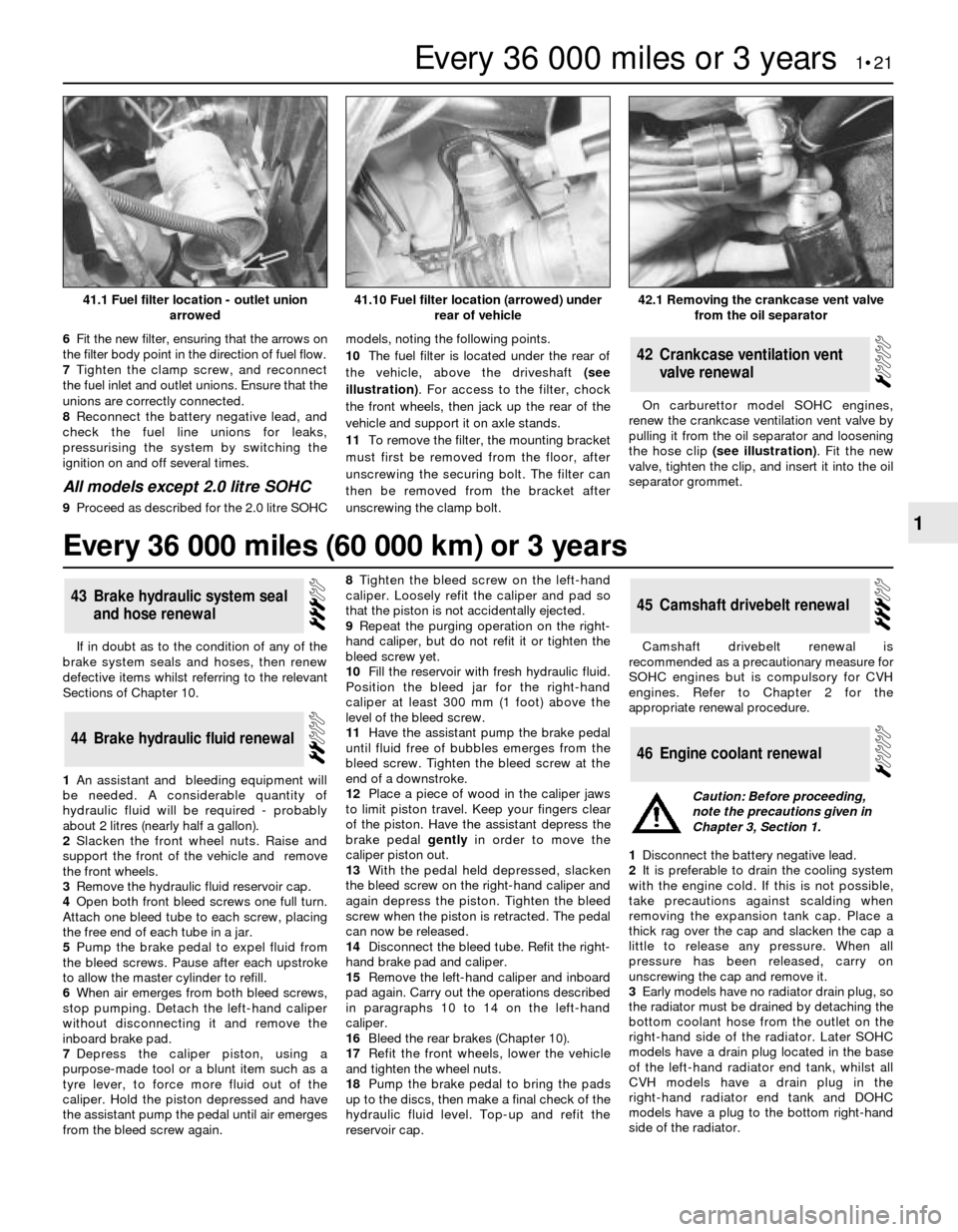
6Fit the new filter, ensuring that the arrows on
the filter body point in the direction of fuel flow.
7Tighten the clamp screw, and reconnect
the fuel inlet and outlet unions. Ensure that the
unions are correctly connected.
8Reconnect the battery negative lead, and
check the fuel line unions for leaks,
pressurising the system by switching the
ignition on and off several times.
All models except 2.0 litre SOHC
9Proceed as described for the 2.0 litre SOHCmodels, noting the following points.
10The fuel filter is located under the rear of
the vehicle, above the driveshaft (see
illustration). For access to the filter, chock
the front wheels, then jack up the rear of the
vehicle and support it on axle stands.
11To remove the filter, the mounting bracket
must first be removed from the floor, after
unscrewing the securing bolt. The filter can
then be removed from the bracket after
unscrewing the clamp bolt.On carburettor model SOHC engines,
renew the crankcase ventilation vent valve by
pulling it from the oil separator and loosening
the hose clip (see illustration). Fit the new
valve, tighten the clip, and insert it into the oil
separator grommet.
42Crankcase ventilation vent
valve renewal
If in doubt as to the condition of any of the
brake system seals and hoses, then renew
defective items whilst referring to the relevant
Sections of Chapter 10.
1An assistant and bleeding equipment will
be needed. A considerable quantity of
hydraulic fluid will be required - probably
about 2 litres (nearly half a gallon).
2Slacken the front wheel nuts. Raise and
support the front of the vehicle and remove
the front wheels.
3Remove the hydraulic fluid reservoir cap.
4Open both front bleed screws one full turn.
Attach one bleed tube to each screw, placing
the free end of each tube in a jar.
5Pump the brake pedal to expel fluid from
the bleed screws. Pause after each upstroke
to allow the master cylinder to refill.
6When air emerges from both bleed screws,
stop pumping. Detach the left-hand caliper
without disconnecting it and remove the
inboard brake pad.
7Depress the caliper piston, using a
purpose-made tool or a blunt item such as a
tyre lever, to force more fluid out of the
caliper. Hold the piston depressed and have
the assistant pump the pedal until air emerges
from the bleed screw again.8Tighten the bleed screw on the left-hand
caliper. Loosely refit the caliper and pad so
that the piston is not accidentally ejected.
9Repeat the purging operation on the right-
hand caliper, but do not refit it or tighten the
bleed screw yet.
10Fill the reservoir with fresh hydraulic fluid.
Position the bleed jar for the right-hand
caliper at least 300 mm (1 foot) above the
level of the bleed screw.
11Have the assistant pump the brake pedal
until fluid free of bubbles emerges from the
bleed screw. Tighten the bleed screw at the
end of a downstroke.
12Place a piece of wood in the caliper jaws
to limit piston travel. Keep your fingers clear
of the piston. Have the assistant depress the
brake pedal gentlyin order to move the
caliper piston out.
13With the pedal held depressed, slacken
the bleed screw on the right-hand caliper and
again depress the piston. Tighten the bleed
screw when the piston is retracted. The pedal
can now be released.
14Disconnect the bleed tube. Refit the right-
hand brake pad and caliper.
15Remove the left-hand caliper and inboard
pad again. Carry out the operations described
in paragraphs 10 to 14 on the left-hand
caliper.
16Bleed the rear brakes (Chapter 10).
17Refit the front wheels, lower the vehicle
and tighten the wheel nuts.
18Pump the brake pedal to bring the pads
up to the discs, then make a final check of the
hydraulic fluid level. Top-up and refit the
reservoir cap.Camshaft drivebelt renewal is
recommended as a precautionary measure for
SOHC engines but is compulsory for CVH
engines. Refer to Chapter 2 for the
appropriate renewal procedure.
1Disconnect the battery negative lead.
2It is preferable to drain the cooling system
with the engine cold. If this is not possible,
take precautions against scalding when
removing the expansion tank cap. Place a
thick rag over the cap and slacken the cap a
little to release any pressure. When all
pressure has been released, carry on
unscrewing the cap and remove it.
3Early models have no radiator drain plug, so
the radiator must be drained by detaching the
bottom coolant hose from the outlet on the
right-hand side of the radiator. Later SOHC
models have a drain plug located in the base
of the left-hand radiator end tank, whilst all
CVH models have a drain plug in the
right-hand radiator end tank and DOHC
models have a plug to the bottom right-hand
side of the radiator.
46Engine coolant renewal
45Camshaft drivebelt renewal
44Brake hydraulic fluid renewal
43Brake hydraulic system seal
and hose renewal
Every 36 000 miles or 3 years 1•21
1
42.1 Removing the crankcase vent valve
from the oil separator41.10 Fuel filter location (arrowed) under
rear of vehicle41.1 Fuel filter location - outlet union
arrowed
Caution: Before proceeding,
note the precautions given in
Chapter 3, Section 1.
Every 36 000 miles (60 000 km) or 3 years
Page 22 of 22
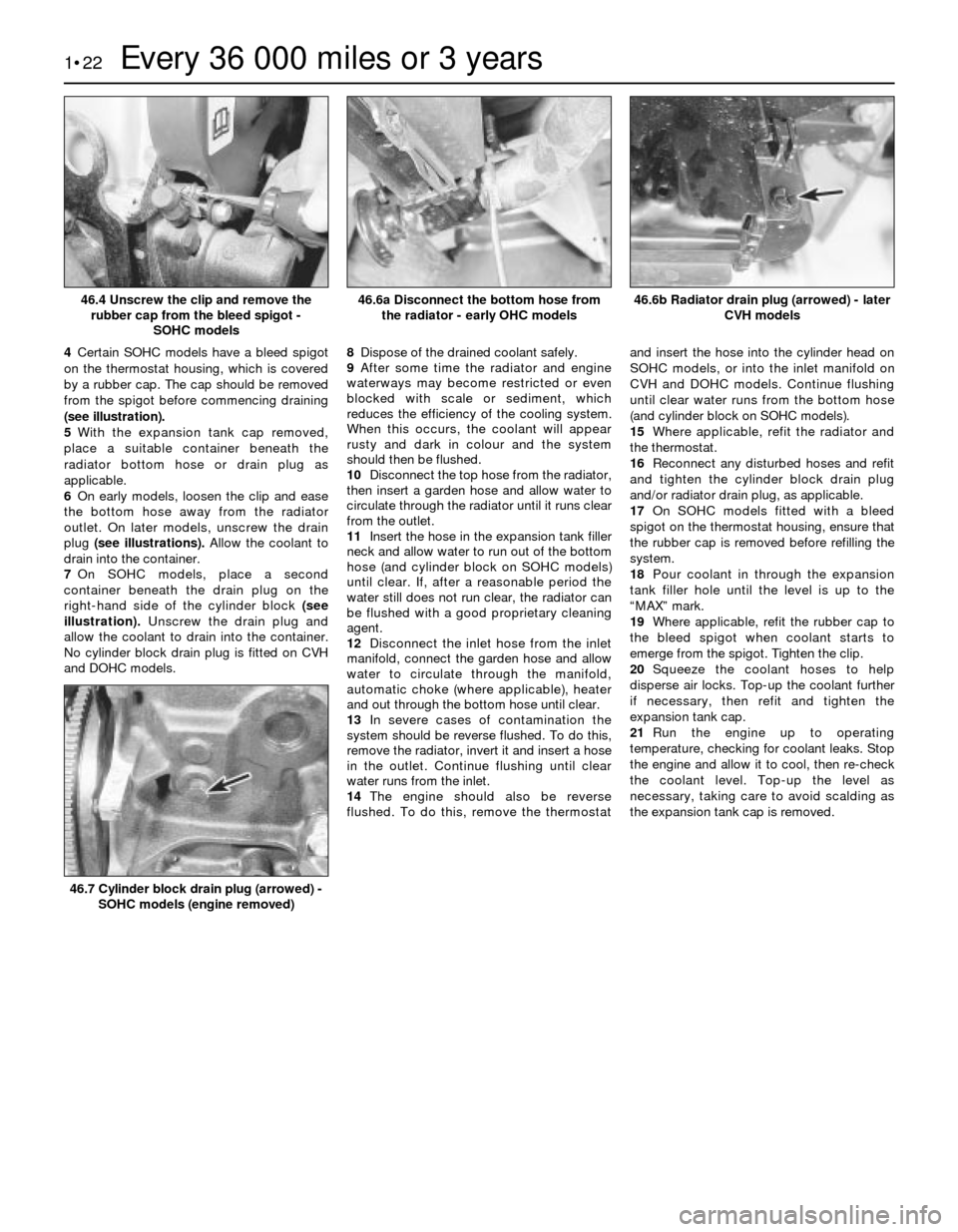
4Certain SOHC models have a bleed spigot
on the thermostat housing, which is covered
by a rubber cap. The cap should be removed
from the spigot before commencing draining
(see illustration).
5With the expansion tank cap removed,
place a suitable container beneath the
radiator bottom hose or drain plug as
applicable.
6On early models, loosen the clip and ease
the bottom hose away from the radiator
outlet. On later models, unscrew the drain
plug (see illustrations).Allow the coolant to
drain into the container.
7On SOHC models, place a second
container beneath the drain plug on the
right-hand side of the cylinder block (see
illustration).Unscrew the drain plug and
allow the coolant to drain into the container.
No cylinder block drain plug is fitted on CVH
and DOHC models.8Dispose of the drained coolant safely.
9After some time the radiator and engine
waterways may become restricted or even
blocked with scale or sediment, which
reduces the efficiency of the cooling system.
When this occurs, the coolant will appear
rusty and dark in colour and the system
should then be flushed.
10Disconnect the top hose from the radiator,
then insert a garden hose and allow water to
circulate through the radiator until it runs clear
from the outlet.
11Insert the hose in the expansion tank filler
neck and allow water to run out of the bottom
hose (and cylinder block on SOHC models)
until clear. If, after a reasonable period the
water still does not run clear, the radiator can
be flushed with a good proprietary cleaning
agent.
12Disconnect the inlet hose from the inlet
manifold, connect the garden hose and allow
water to circulate through the manifold,
automatic choke (where applicable), heater
and out through the bottom hose until clear.
13In severe cases of contamination the
system should be reverse flushed. To do this,
remove the radiator, invert it and insert a hose
in the outlet. Continue flushing until clear
water runs from the inlet.
14The engine should also be reverse
flushed. To do this, remove the thermostatand insert the hose into the cylinder head on
SOHC models, or into the inlet manifold on
CVH and DOHC models. Continue flushing
until clear water runs from the bottom hose
(and cylinder block on SOHC models).
15Where applicable, refit the radiator and
the thermostat.
16Reconnect any disturbed hoses and refit
and tighten the cylinder block drain plug
and/or radiator drain plug, as applicable.
17On SOHC models fitted with a bleed
spigot on the thermostat housing, ensure that
the rubber cap is removed before refilling the
system.
18Pour coolant in through the expansion
tank filler hole until the level is up to the
“MAX” mark.
19Where applicable, refit the rubber cap to
the bleed spigot when coolant starts to
emerge from the spigot. Tighten the clip.
20Squeeze the coolant hoses to help
disperse air locks. Top-up the coolant further
if necessary, then refit and tighten the
expansion tank cap.
21Run the engine up to operating
temperature, checking for coolant leaks. Stop
the engine and allow it to cool, then re-check
the coolant level. Top-up the level as
necessary, taking care to avoid scalding as
the expansion tank cap is removed.
1•22Every 36 000 miles or 3 years
46.4 Unscrew the clip and remove the
rubber cap from the bleed spigot -
SOHC models46.6b Radiator drain plug (arrowed) - later
CVH models
46.7 Cylinder block drain plug (arrowed) -
SOHC models (engine removed)
46.6a Disconnect the bottom hose from
the radiator - early OHC models